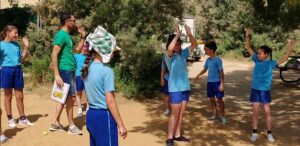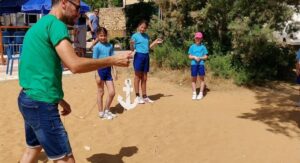BeMED 10. Posidonia oceanica – litter within and without
Title |
Posidonia oceanica – litter within and without |
| Author | Johann Gatt |
| Age Guide |
Year 4-8 |
| Subject Area |
Science, Mathematics, Arts and crafts, Languages, ESD |
| Estimated Duration | 2½ hours – an outdoor session on a sandy beach. |
| Site | Any sandy beach ideally with visible posedonia banquettes. Also ideally there is a wooden ramp that extends as close as possible to the shoreline to render access to learners using mobility assistive devices. |
| Educational objectives | To identify from drawings plant parts of the seagrass Posidonia oceanica and outline the life cycle in simple words.
To mention two marine species that live and thrive within the posedonia meadows. To list key benefits of the seagrass Posidonia oceanica. To mention threats leading to the potential loss of posedonia meadows. To discuss solutions that could help protect the existing meadows and prevent further loss of Posidonia oceanica. To propose some possible non-conventional methods to protect the species. |
| Learning Outcomes | – I am able to creatively and innovatively take considered action and challenge assumptions underlying unsustainable practice.
– I am sensitive to divergent disciplines and perspectives, cultures and minority groups without prejudices and preconceptions. – I can justify the importance of identifying problems, reflecting critically, thinking creatively and having a wider vision in order to plan for the future and become an effective agent of change. – I can reflect upon the consequences of my actions on present and future generations. – I am able to collaborate with other learners and the educators facilitating the session. |
| Link to SDGs | SDG 14: Life below water |
| Educational resources required | Appendix 10.1 – details of Game
a set of printed photos in display file to be used during game and explanation – Appendices 10.2 to 10.9: Appendix 10.2 – Benefits Appendix 10.3 – Distribution Appendix 10.4 – Life Cycle Appendix 10.5 – Parts Appendix 10.6 – Protection Appendix 10.7 – Species living in it Appendix 10.8 – Threats Appendix 10.9 – Uses 2 small dice: one red, one green A cup or non transparent holder for dice Deep tray, dish or flat surface to throw dice on (at the beach) Timer/alarm (optional) Internet Connection for remote preparation |
| Remote preparation | For Year 4 – 6 students: Video to be used as a discussion primer in class https://www.youtube.com/watch?v=TPCgLonKaf0
For Year 7 – 8 Learners: Video Importance of Posidonia Oceanica as an introductory tool to the outdoor session https://www.youtube.com/watch?v=3-X8VX_sK1Y |
| Planning Considerations | – Check if ERA/Local Council permits are a pre-requisite before visiting site.
– Clearance from the respective Health and Safety body overseeing outdoor site assessment. – Pre-visit to the site to check for health hazards or potential threats and basic amenities. – Re-visiting again a few hours before the activity. – Look for ideal spots and resources in situ. Ideally many of the resources are to be sourced from the site to avoid carrying a lot of material, but in full respect and senstivity to the site being used. – Strict adherence to ERA permit at all times to avoid disturbing the site. – Reminders for appropriate footware, safety gear, clothing. |
| Method | Introduction
– Ideally the students watch the video/s suggested in Remote Preparation before they actually venture out on site for this session. The idea is to use these as discussion primers and as a means to assess prior knowledge. – Alternatively the teacher might decide to show a series of pictures related to the beach such as a sand castle, deckchairs, goggles, turtles, starfish, crabs, seahorse, etc including also a picture of the dead seagrass leaves strewn on a beach and ask the kids to place them in order of preference. – Leading questions might include; – Do you love to go to the beach? Why? – Do you prefer sandy beaches or rocky ones? Why? – What kind of activities do you usually do at the beach? Snorkeling, fishing, swimming..? – Do you have a favorite beach? – What makes it so special? The teacher records these answers for future reference. Development – Drawing on the main points of the short documentary The Importance of Posidonia Oceanica https://www.youtube.com/watch?v=3-X8VX_sK1Y – The teacher walks slowly along the splash zone to explain some key points about the life cycle of Posidonia oceanica. – The teacher may collect seagrass parts that have been washed ashore to help the students identify specific plant parts and their function. – Through a series of pictures (taken on site in a display file) and referring to specific items on site (and the extensive references indicated hereunder in the respective section) the teacher elaborates on the following; – Life-cycle and plant parts – Photosynthesis and carbon sequestration – Flowering and fruiting bodies – Benefits and uses – Threats – Possible solutions (eliciting also some from the learners) A game is then used as a consolidation exercise. The game is quite simple and straightforward. Two-thirds of the students are asked to distribute themselves randomly across a stretch of sand with 1.5 m away from each other. They are asked to imagine that each one of them is a Posidonia oceanica leaf. All the leaves are rooted to the seabed forming a meadow and swaying along the ocean currents. Whilst the rest of the learners are testing out the swaying motions. The challenge of the game is to avoid as many threats as possible. Threats will come in all forms and sizes as indicated in Appendix 10.1 (red column). How to play? – You need two small dice. One red and one green. – Players are to keep swaying in a wavelike motion ALL the time. Any players that are spotted not swaying will be eliminated. – The dice are placed in a cup and one of the players must take a dice without looking and throws the dice. – Read the ‘news’ in Appendix 10.1 according to the colour of the dice and number thrown. – The ‘news is discussed and action taken. Eliminate/reintroduce students according to the number shown on the dice. Each time explain why the players are either being eliminated or re-introduced to refer to the threats and solutions that determine the fate of the posedonia meadows. The person who throws the dice and classmates around are eliminated if a red dice is picked according to the number on the dice.
g part of the posedonia patch can mime the action related to the news (eg. slime on the posedonia grass, Patrol, …) – There are two extra benefits and threats actions should one want to vary a bit the game to make it more exciting instead of repeating the same choices.
– When the time is up the surviving posedonia players win whereas the eliminated ones lose. Conclusion – Refer back to the preference list and ask them if they think they would re-arrange it and justify their reasoning. – The idea is to make them aware that even the sand castle and much of the beach life ultimately depends on the seagrass that attenuates the wave ocean and the same banquettes that prevent coastal erosion. – It would be interesting to check if in the absence of Posidonia oceanica their favourite beach would remain such. – The lesson will ideally end with a series of questions; – Do you think there is enough awareness about Posidonia oceanica? – Do you think it needs to be protected? – What makes you think so? – Are we doing enough to protect it? – Can you do this as a student? – Is there anything more you would do? – If you had to be given the opportunity to be a beach manager what is the first decision you would take? – Why do you feel it is so important? – From all the SDGs to which are the issues we mentioned today mostly related? – The follow up activities (some of which can also be carried on site) will include several possibilities to help students take informed decisions. |
| Follow-up activities | – An organised clean up of the area to collect waste items along the shore. Learners are then asked to get creative by using the debris collected to come up with a strong message for the general public Make sure that whatever craft they create can be easily dismantled and disposed of separately to be properly recycled.
– Students discuss to decide on the craft item to be made or else they can draw a picture story by scribbling on the sand to show how the micro-plastic fibres can eventually end up on our plates. They can use the same debris that is lying around to compose their story on the sand. The teacher might want to show them some pictures of plastic fibres that were lodged in fish stomachs from the display file or else if there is not enough time left on the beach, they can watch the video in class; https://www.youtube.com/watch?v=_6xlNyWPpB8&feature=emb_logo – Role play – boat owners vs enforcement officers: A team of 5 students taking the role of boat owners and a team of 5 students taking the role of environmental officers engage in a debate with an appointed moderator. Ideally if you intend to have 3 debates, all the boat owners meet in one group and all the environment officers meet in another to work before the actual debates. The idea is to prepare the salient points of the arguments they intend to put forward during the debate. |
| Background information for educators | Background knowledge for the educator from reliable sources:
https://era.org.mt/wp-content/uploads/2019/09/BioSnippet_19-Neptune_Seagrass.pdf https://medwet.org/2017/10/mediterranean-posidonia/ https://kids.frontiersin.org/article/10.3389/frym.2018.00002 https://era.org.mt/operating-procedures-on-beach-cleaning/ http://www.marinespecies.org/introduced/wiki/Mediterranean_seagrass_ecosystem |
| Adaptations | For students with learning difficulties
– A printout of the species that live in the seagrass to colour in. – A diorama which would include a shoe box with the coloured seagrass marine animals to create a model representing a scene with three-dimensional figures. – A set of photos used by the teacher (during the outdoor session) is printed and placed face down. They each choose one photo. Back home they write a couple of sentences about the photo depending on their age and ability. |
| Extensions | For gifted students:
– To propose some non-conventional ways to protect the posedonia meadows – policy document preparation to be presented at parliament like an MOU with the boat owners’ association. One idea could include writing officially to the Malta Cruising Club – http://maltacruisingclub.org/wp/?page_id=214 for example. – Write to Transport Malta: https://www.transport.gov.mt/maritime/local-waters/maritime-leisure-activities-89 – Further reading: an article about the effect of plastic micro-fibres in seagrasses. http://www.bu.edu/articles/2019/microplastic-pollution-in-ocean-seagrasses/ |

 – The students eliminated/not formin
– The students eliminated/not formin – You can time the game and use an alarm to end the game, otherwise it can go on for quite some time.
– You can time the game and use an alarm to end the game, otherwise it can go on for quite some time.


